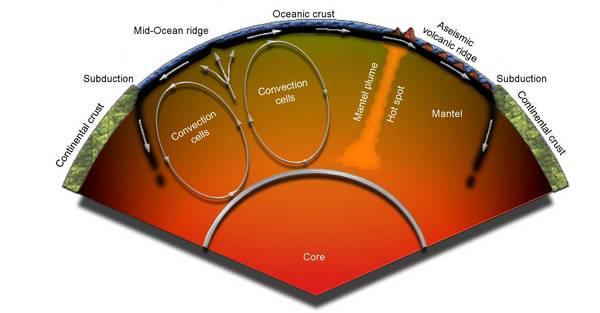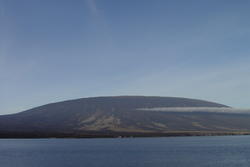Generation Types / Hot Spot
Generation Types
2 Hot SpotAt a first view, the active volcanoes of the Galapagos and Hawaii are not located near the plate boundaries of the Earth's shifting crusts where the great majority of the world's earthquakes and active volcanoes occur. More than 1000 km away from the closest subduction zone and a few hundred km from the nearest Mid Ocean Ridge somewhere in the Pacific Ocean, the presence of these volcanic islands at Galapagos offer similar to the Hawaiian islands a very different geodynamic setting and origin. Therefore, some four decades ago, the “Hot Spot” hypothesis became widely accepted because it agrees well with much of the scientific data obtained around the globe in general and the Galapagos Islands in particular. Hereby a “hot spot” represents a region of intense heat within the Earth's mantle. This hypothesis, however, states that there is a mantle plume of intense heat that is relatively stationary and deforms the oceanic or continental crust or plate above it. These crusts or plates ride over the “long-living” hot spot and are occasionally perforated by the molten rock that is rising from the Earth's mantle. The crust or plate above the stationary mantle plume is forced upward because of the heat, and subsequently volcanoes are formed. In case of an oceanic plate above, a mantle plume volcanic islands are formed (of course after having active submarine volcanism first). Therefore, with ongoing activity, the previously formed islands then move slowly away from the hot spot, making room for new islands to be formed by further volcanic activity. The older volcanoes eventually become inactive and slowly erode into the ocean depths resulting finally to linear volcanic chains many thousands of kilometers long.
This is just one (of many) geologic explanations for the Galapagos Islands, which postulates a small area of abnormally hot rock, a “hot spot” deep beneath the ocean floor. The hot spot is firmly rooted in the Earth´s interior, while the bedrock of the ocean floor glides slowly over it. Molten rock erupts from the hot spot onto the ocean floor and builds a volcano, which grows above the waves until the ocean floor carries it far to the east. Beyond its lava supply, the old volcano goes out of business, and a new volcano begins to build above the hot spot. It might sound curious to imagine that solid rock flows in convection currents inside the Earth due to the fact that the rocks we know at the Earth´s surface are cold, stiff and brittle but it does so in the Earth’s interior where very high pressures and temperatures rule. Under such circumstances rocks become soft and plastic in much the same way that hard wax becomes soft and pliable as it warms in ones hand. The geneal assumption is that hot rock in the upper mantle sometimes rises in narrow plumes, like smoke rising from a chimney. A plume head heats the lower side of the Earth´s outermost solid layers of the lithosphere, and, when the mantle plume burns its way through, it leads to a throw up of a massive amount of basaltic flows, which may form large igneous provinces that include huge oceanic plateaus. Hot spots are undetectable to most of the conventional methods used to examine the Earth´s interior. Geoscientists of all kinds have no firm data to help explain how hot spot plumes start rising or from what depth. The vapors blowing out of hot spot volcanoes, contain surprisingly high concentrations of some very rare elements, which are not frequently found in the “regular” Earth´s surface. Some geologists regard this as evidence that the plume is rising from an extremely deep root. Others do not. Some geologists believe that hot spot plumes start spontaneously where large masses of hot rock rise from peaks in the boundary at the top of the Earth´s molten core. Others suggest that they originate at depths of only 650 to 670 km, where we encounter the boundary of Earth´s upper and lower mantle, where pressures forces the abundant mineral olivine to change its crystalline structure, forming a boundary from which escaping heat can rise. A further group of geologists believe that a hot spot rises due to subducted oceanic crust may does nor melt completely at subduction zones. This so far at a first step unmelted part turn into a loop and sinks either at the Earth´s upper/lower mantle boundary or even to the lower mantle outer core boundary at 2900 km depth and after a certain residence time becomes in a way “recycled” and because of this “recycling” process it becomes lighter and therefore less dense which leads this material to rise up and form a hot spot. Some geologists even speculate that plumes develop at sites where enormous asteroids strike the Earth and explode, opening a path for heat to escape from the interior. However, for all theories real data are still lacking. Nonetheless, a huge and growing fraction of scientists based on their data conclude that mantle plumes simply don't exist. Their theory explains the presence of a volcanic Galapagos or Hawaii by simple cracks or fissures in tectonic plates. After all, plates stretching 10,000 kilometers are unlikely to remain perfectly unbroken. Having any break in the skin of a plate and it seems reasonable that molten rock would flood up to fill this potential gap. This would explain volcano formation without any mantle plume. |
Source: MBG Video-file, length: 0.50 minutes, 860kb
Figure: Alcedo Shield Volcano (Isabela, Galapagos, Ecuador); Source: MBG
|

